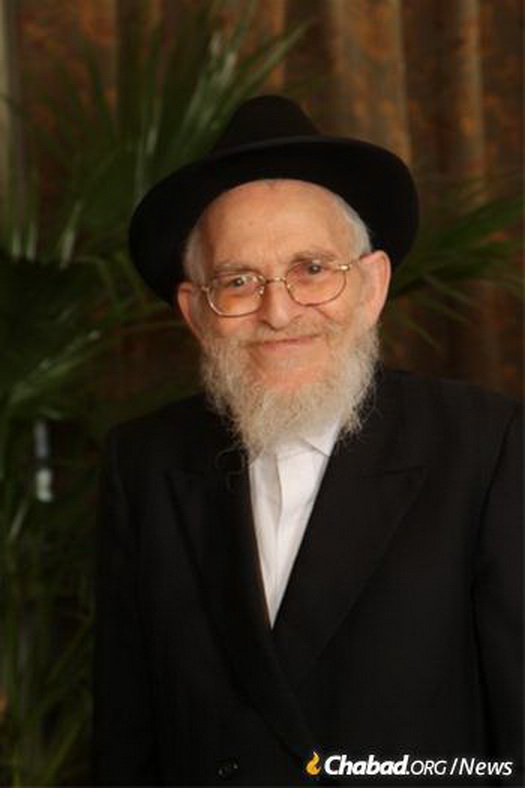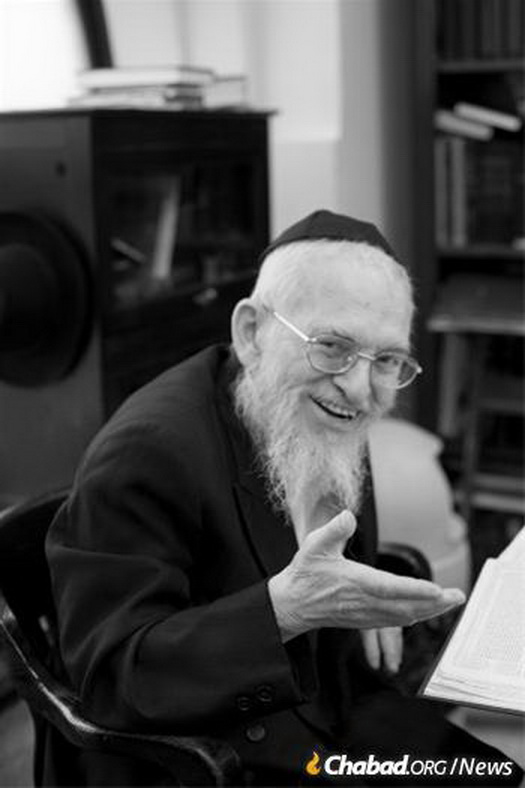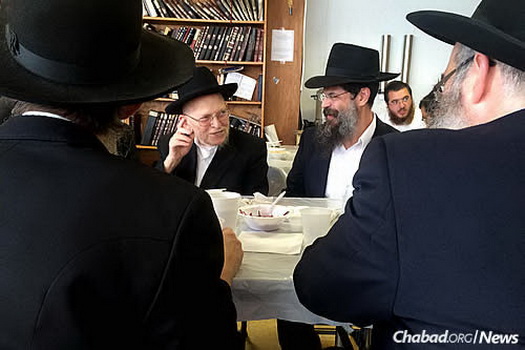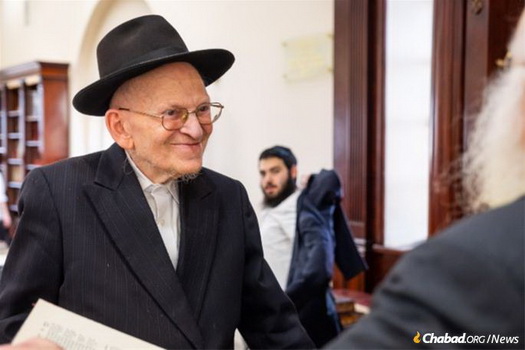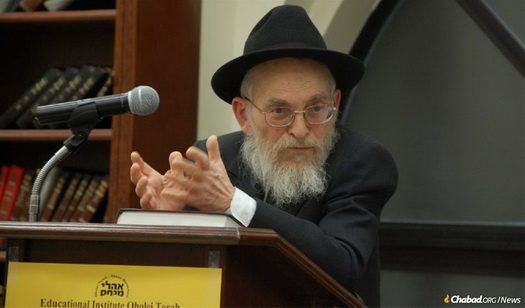
Obituary: Rabbi Yisroel Friedman, 84, Talmudic Genius and Fiery Chassid
by Menachem Posner and Eli Rubin – chabad.org
Famed worldwide as a giant of Torah learning whose prowess as a Talmudist was matched by the depth with which he studied and applied the teachings of Chabad, Rabbi Yisroel Friedman was not only filled with Torah knowledge, but also with love for the Torah and with unbounded dedication to G‑d, the giver of the Torah. Serving as the senior rosh yeshivah (head of the academy) at Talmudic Seminary Oholei Torah in Brooklyn, N.Y., for more than 50 years, he became known as the very personification of “a Chassidisher rosh yeshivah.” He was also a member of the Central Committee of Chabad-Lubavitch Rabbis (Vaad Rabonei Lubavitch Haklali).
He passed away April 1 at the age of 84, after contracting the coronavirus.
His penetrating insights were sought after by scholars from around the world, who knew that he could be relied upon to provide well-reasoned explanations, culled from across the breadth of Torah wisdom. For many decades, he was a sought-after and honored presence at the international summit of Torah scholars that convenes each summer in Parksville, N.Y., to honor the memory of Rabbi Levi Yitzchak Schneerson, father of the Rebbe—Rabbi Menachem M. Schneerson, of righteous memory. “It is a point of pride to visit with people who were once students,” he told Chabad.org in 2016, “and have now become teachers and leaders in their own right.”
A wiry man with a broad grin, he would appear to dance lithely from his seat as he lectured before the senior Talmud class at Oholei Torah, to which students were only admitted in their final year at the seminary. Brimming with excitement and evident pleasure, his delivery was sharp and measured, accentuated by his peppery Yiddish and energetic gesticulation. Despite the intellectual rigor that he both displayed and demanded, many of his students noted that his attitude in Talmud class was always lighthearted, jovial and warm. His sharpness—and the seriousness of the subject matter—was both tempered and complemented by sparkling humor. While he approached the study of G‑d’s Torah with awe, he regarded his own intellect with a strong measure of self-deprecation.
His attentiveness to the Talmudic commentary Rashi was legendary. While many treat Rashi as an aid to understanding the basic meaning of the Talmudic discussion, he treated Rashi as a profound work of masterly concision. Each word was a gold mine to be quarried for luminous insight. At the same time, he could not tolerate attempts to shoehorn novel explanations into Rashi’s words. “Don’t tell me what Rashi means to say,” he would exclaim, “tell me what Rashi says!” Seeing a young student studying one of the more complex works of later commentary, he was liable to gently remind them not to get too ahead of themselves; “You need to study Shaarei Yehudah? I’m still trying to understand Rashi!”
This self-deprecation would completely disappear when, in the more informal setting of a chassidic gathering (farbrengen) he would speak with utmost seriousness of the personal obligation of the individual before G‑d. On these occasions his fiery chassidic persona would come to the fore. Citing passages from classical Chabad works—such as Tanya or Likutei Torah—from memory, and analysing them word by word, he placed great emphasis on the need for constant spiritual renewal and self-transformation, to ensure that each, thought, word, and action be dedicated to the service of G‑d. In this context too, his good humor and sharp wit were always on display, and he would pepper his discussion with a rich reservoir of lively chassidic anecdotes, vividly conjuring up the great chassidic personalities of bygone generations.
In between these searching and lively talks he would pause to sing a resonant chassidic melody, closing his eyes and immersing himself with rigor and resolution in the vocalization of pure spirit.
On special occasions, such as Yud Tes Kislev or Yud Shvat, he would hold forth from late evening through the night, while surrounded on all sides by young students and senior rabbis who sat and stood crowded together, and leaning over each other, to hear each gleaming word. Depicting one such farbrengen, his student Rabbi Mendel Rubin wrote, “Never at a loss for words, he flows seamlessly between the revealed and the concealed parts of Torah, weaving in and out, with poignant anecdotes and swift flashes of humor thrown in at every turn.”
Descendant of Chassidic Luminaries
He was born in the Belarusian city of Beshenkovitz, then part of the Soviet Union, in 1936, to R. Yaakov and Gittel Friedman, prominent members of the Boyan Chassidic dynasty. His father was a direct descendant of Rabbi Dov Ber, the Maggid of Mezritch, who succeeded Rabbi Yisrael Baal Shem Tov as leader of the early Chassidic movement, and their home was steeped in Torah learning and Chassidic fervor, which even the Soviet claws could not touch.
With the outbreak of World War II, Yaakov Friedman was drafted into the Russian army and was never seen by his family again.
Gittel Friedman and her three sons fled to Samarkand, far from the advancing war front. There, they encountered Chabad Chassidim, who had built an elaborate underground network of Torah institutions. Eager to help, the Friedmans hosted an underground Torah class for youngsters in their home, thus becoming forever part and parcel of Chabad.
After the Iron Curtain parted briefly following the war, the Friedmans joined the thousands of Chabad Chassidim who snuck out to the West using forged documents.
All throughout the tumultuous period, young Yisroel assiduously studied Torah.
After escaping Russia, Yisroel and his family spent time in Poking, Germany, and in Brunoy, France where he celebrated his Bar Mitzvah. The noted Chassidic mentor, Rabbi Shlomo Zalman Kesselman (who was also in Brunoy at the time) took it upon himself to help the young man study, understand and memorize a Chassidic discourse to mark the occasion. “He taught me a discourse from Sefer Maamarim Yiddish [which had only recently been published],” Reb Yisroel remembered, “over the course of two weeks he invested much time, training me to enunciate the difficult and long Yiddish words … and in the end, with Reb Shlomo Chaim’s help, I was able to repeat the discourse fluently.”
From this experience Reb Yisroel also learned something about education: Of Reb Shlomo Chaim he would later say, “for him there was absolutely no concept of investing more on the students who are already excelling over and above providing younger students—who are only just beginning to climb the ladder of inner work—with foundational instruction.”
He, his mother and his brothers eventually made their way to Israel, where the boys enrolled in the Chabad yeshivah in Lod.
In 1954, the youthful scholar published a pioneering journal titled Pardas Hatamim – Chabad, together with two other students—Yehudah Leib Landa (later to become the Chief Rabbi of Bnei Brak, Israel) and Meir Tzvi Gruzman (later to become rosh yeshivah in the central Chabad Yeshivah in Kfar Chabad). The editor-in-chief was their rosh yeshivah, Rabbi Boruch Shimon Schneersohn, who had been one of the prize students of Rabbi Meir Shapiro in Yeshivas Chachmei Lublin, and would later head the famed Yeshiva of Tchebin in Jerusalem. The agenda set by the editors was ambitious. They wanted to introduce the unique qualities of the Chabad yeshivah and its curriculum to the wider community of Torah scholars. Alongside involved discussions of complex Talmudic and halachic questions, they also published recent letters and discourses by Rabbi Menachem M. Schneerson, who at that time was “the new Lubavitcher Rebbe.” In the foreword they gave a full account of Chabad history in the first part of the 20th century, presenting the clear message that Chabad was on the threshold of a new era of growth both quantitatively and qualitatively, which would be catalyzed by animated Torah study and an educational revolution.
Not long after this, another episode occurred that served to highlight the brilliance of the young orphan. A certain rabbi, of non-chassidic stock, sought to take up a position teaching Talmud in the yeshivah. The ire of Yisroel was quickly raised when the would-be-teacher began his lecture by rejecting the explanations provided by the classical commentaries. Rather than attempting to plumb the depth of their intention, he proposed a “clever” new interpretation of his own. Even at that age, Yisroel had absorbed a deep sense of love and reverence for each word of Torah that is received from the great authorities of previous generations, and he knew that such “cleverness” was anathema to the chassidic approach to Talmud study. Although still a teen and generally of a modest disposition, he deployed his broad knowledge and keen wit to expose the ignorance, arrogance and sophistry of the auditionee.
First Encounter With the Rebbe
In 1956, Reb Yisroel came to New York to study in close proximity to the Rebbe, who recognized the young prodigy’s abilities. He first entered the Rebbe’s room on the 12th of Kislev, which is known as a uniquely Chassidic month, the Rebbe greeted him with the exclamation that he was “a kislevdiker,” which roughly means that he was of a disposition well suited to the month of Kislev. For anyone who knew Reb Yisroel, that remark rings very true.
In that first meeting with the Rebbe, he recalled being astonished by a first-hand revelation of the Rebbe’s unique abilities. In the note that he gave to the Rebbe he had requested a blessing for his mother’s health, using the rabbinic phrase “in her 248 organs and 365 sinews.” Moments before entering the Rebbe’s room the thought occurred to him that since a woman is anatomically different to a man he should have written “in all her limbs and sinews.” By then he was already at the door and so he entered and handed the note to the Rebbe without making the change. But even before looking at the note the Rebbe began a discussion about various sources in the Talmud according to which a woman has 252 organs. “He spoke with me at some length about the difference in opinion about this. I was completely amazed that the Rebbe began to talk to me about this even before he began looking at my note.”
In that meeting he also confided in the Rebbe regarding a number of issues that were bothering him. The Rebbe replied: “Sit and learn and forget about everything else.” At the conclusion of the meeting, the Rebbe chided him gently for not arranging a place to sleep in New York. “Yisroel,” he said. “Take care that wherever you sleep there should be a pillow upon which to place your head.” As a point of fact, however, Yisroel did not sleep that night: “we sat and farbrenged all that night, until the Rebbe had finished receiving people in his room, and returned home.”
This marked the beginning of a new era for Reb Yisroel. “In those days,” he would later recall, “the Rebbe had a very special relationship with the yeshivah students. By the nature of things, being that there were so few of us, the Rebbe drew us very close.”
Reb Yisroel came to recognize, to an ever greater degree, the central role of a Rebbe in the spiritual life of a Jew. An ordinary person, he would later explain, sees the existence of the world as axiomatic and obvious. The existence of G‑d, on the other hand, is something that needs to be recognized; we may be believers, but from a purely natural perspective this is not a forgone conclusion. We need to constantly remind ourselves of the truth at every moment. But there are souls that descended into this world from on-high, and the world does not conceal the truth from them. “For them … G‑d is obvious … and proof is required that the world too exists.” Having a connection with Rebbe, accordingly, connects you with the truth of divine being as it remains untainted by the prism of earthly existence. Thereby, all your Torah study and all your mitzvah observance can be permeated by the radiance of that truth. Over the course of many decades, the centrality of this connection was often the topic of Reb Yisroel’s farbrengens.
In 1959, even before his marriage to Chana Luba Gurkow, the Rebbe instructed him to begin teaching Talmud in the Chabad yeshivah in Newark, N.J. (which subsequently relocated to Morristown). He immediately grabbed his coat and rode there without even taking the time to collect his belongings.
During that period, Reb Yisroel later recalled, he would send detailed reports about the progress of individual students to the Rebbe. On one occasion he received a message from the Rebbe that he relies on these reports when making decisions about sending students as emissaries (shluchim). He also recalled that in general his meetings with the Rebbe were very brief. He would hand the Rebbe his note and leave, if there were questions the Rebbe would reply in writing. But it once happened that the Rebbe took out a note from a previous visit out of his desk, and began to discuss a particular problem he had mentioned concerning two students who were having difficulty studying together. “The Rebbe answered me at length, directing me as to who to deal with the issue in detail, saying that they should continue to study together, and instructing me as to how to resolve the problem.” This not only helped the students, but it affirmed for Reb Yisroel the importance of such attentiveness to the individual needs and challenges of each one of his young charges.
When his uncle, Rabbi Michoel Teitelbaum, started an advanced class in Oholei Torah, it was only natural for Reb Yisroel to come teach there. Rabbi Yosef Itkin, now a mentor (mashpia) at Yeshiva Schools of Pittsburgh, was in the first class taught by Reb Yisroel in Oholei Torah. Itkin recalls that the two most salient features of his teachings style were 1) the uncontainable energy and excitement he had for Talmud study, 2) his unwavering commitment to train his students to toil assiduously for nothing less than the raw truth in its purest form. “There is another style of teaching and learning, which in many ways is easier and more enjoyable, and that is the way of a good question and a good answer, something clever, something elegant; a proof from here, a counter proof from there. But that wasn’t Reb Yisroel’s way. He wanted us to understand Rashi and the other early authorities properly, clearly, using straight thinking. The main thing for him was that we shouldn’t fool ourselves.” The students did not simply respect their teacher. “We trusted him. We knew he was true to himself, true to the Rebbe, and that he would be true to us.”
At the end of that first year a summer yeshivah was held, and Itkin recalls that on Shabbos Reb Yisroel would pray at great length, in the classic chassidic style, but with a special intensity that didn’t abate once he had finished praying. After making kiddush he would begin a farbrengen with his students, and it often went deep into the night, many hours after the official conclusion of Shabbos.
Indeed, he would continue to teach and farbreng for successive generations of students for another five decades. Even into his seventies and eighties, when his fiery red beard had turned white, his youthful alacrity did not diminish. He was the living heart of the yeshivah, and his presence in Crown Heights had a daily impact on the entire community.
“His presence was felt well beyond the yeshivah,” recalls Rabbi Joseph Rosenfeld, longtime executive director of Oholei Torah. “He taught an advanced class in Menachot in the synagogue near his home, and people would come night after night to delight in the way he explained things.” Likewise, on Shabbat afternoon, between the mincha and maariv prayers, he would often repeat a chassidic discourse that he had committed to memory. Here too his delivery was a delight; in his usual clear-cut Yiddish the words gushed forth with fluency and animation, and wherever necessary he added words of explanation and clarification.
A Fiery Chassid and a Master Teacher
One former student recalled that when he was first enrolled in Oholei Torah one of his uncles commented that it would be worth studying at the institution “if only to watch Reb Yisroel daven mincha.” Even as he prayed the shortest prayer of the day, in the midst of all the hubbub of the great study hall of the yeshiva, the quiet seriousness with which the Rosh Yeshivah stood before G‑d spoke volumes.
“He was a giant among giants with his incomparable knowledge in all aspects of Torah, chassidus and halachah,” attested Rabbi Yehuda Ceitlin, who organizes the annual summer summits, where he was a revered and beloved participant. “He was also clear-minded and sharp-tongued, which would be expressed during the intense learning sessions, but even while he was critiquing an opinion of a fellow rosh yeshivah, he would do so with a chuckle.”
Rabbi Friedman was renowned as a master teacher who built close personal relationships with his students, though most would only attend his class for one year. All who studied with him or saw him teach were impressed by the clarity with which he parsed a difficulty or distinction in Talmudic reasoning, and by the spirit and wit with which he engaged and animated his listeners. He was not only attentive to the progress his students made in learning and in spiritual affairs, but also to their material needs. He kept a fund that he would use to help students in need, always exhibiting exemplary discretion, care and sensitivity, say his colleagues and students.
“Reb Yisroel was unique in that he was very close to his students,” recalls Oholei Torah director of development Rabbi Nosson Blumes. “He was a Talmudist of the highest order, the likes of which one rarely sees, yet he was intimately involved in their lives. He would go out of his way to purchase coats, shoes, and jackets for students in need, even paying tuition from his own modest funds.”
Though he never took himself seriously enough to commit his scholarly novella to writing, it is well known that the Rebbe strongly encouraged that people should publish new Torah insights and discussions. As a faithful Chassid, Reb Yisroel not only acquiesced, but took a leading role in facilitating and editing the work of Oholei Torah students. His penetrating articles on Talmudic topics can be found in Oholei Torah, an annual collection of novella published by the yeshivah, as well as in Kinus Torah, a periodical published by the Rebbe’s secretariat whose articles originated as contributions to Torah conferences held in the Rebbe’s synagogue at 770
In his later years, he battled mightily against cancer, but never missed a beat. He pushed himself with superhuman strength to teach his students and speak publically whenever asked. Even once he was no longer giving all his daily classes he would regularly be seen in the study hall, sitting with a chavruta (pair of students) to ensure that they were progressing in their studies, offering them his characteristic mix of attentive patience and witty humor.
The funeral took place on Wednesday, as the community — and the City of New York — is sheltering in place due to the ongoing pandemic. The funeral procession weaved through much of the Crown Heights neighborhood of Brooklyn to allow residents to pay their last respects — from outside their homes, without congregating — to the beloved and revered Torah scholar who humbly walked in their midst for decades.
Predeceased by his wife in 2014, he is survived by his daughter, Rochel Friedman, and thousands of students worldwide.
